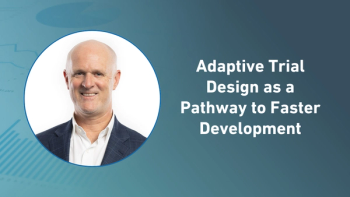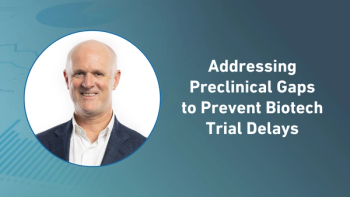
Applied Clinical Trials Supplements
- Supplements-01-02-2009
- Volume 0
- Issue 0
The Changing Core Laboratory
How one lab is using continuous process improvement to decrease timelines and redefine itself.
Much has been discussed and written about the potential value of metrics and how sponsors of clinical trials can use them to monitor the performance of organizations that they contract with to implement their development trials.
One such vehicle is the Metrics Champion Consortium (MCC). The mission of the MCC is to develop, through a collaborative process, performance metrics within the biotech and pharma industry with the intent to jointly encourage performance improvement, effectiveness, efficiency, and appropriate levels of controls for both sponsors and service providers including imaging core labs.
Initiatives like these should promote greater transparency between imaging labs and sponsors on what are believed to be important metrics. While most believe this is a step in the right direction, significant incremental benefits can be achieved for sponsors and imaging labs that focus on the operational improvements underlying the metrics—improvements that can accelerate the development process, allowing companies to ultimately bring new therapies to market quicker and at lower cost.
Metrics in and of themselves don't enable operational efficiencies. What can are continuous improvement initiatives applied to the underlying processes being measured. The mere existence of metrics doesn't necessarily provide any insight whatsoever as to the quality or even the existence of credible continuous improvement programs.
Three New Benefits for Clients
Unfortunately this focus on continuous improvement has not begun to happen in a meaningful way. The focus of this article is to highlight the impact effective continuous improvement programs can have on both the organizations that implement them and their clients, who in this case are the drug and device companies that sponsor clinical trials.
Driving the process
As sponsors look for new ways to accelerate their development programs, they are looking for imaging core labs that can do the following:
- Commit to and deliver upon aggressive timelines and milestones. Committing can be the easy part. According to many anecdotal stories, delivering upon these commitments can prove challenging.
- Provide more rapid and complete feedback of results to the study teams, allowing them to react much sooner.
- Reduce cost where possible without sacrificing quality or adherence to timelines.
There are multiple ways an imaging core lab can react to these ever increasing demands. The method most frequently chosen is for the service provider to develop concurrent internal processes that essentially create two classes of customers within the organization. One class that represents the most demanding projects (i.e., those requiring tighter time lines and oversight by many in the organization), and a second class of customers or projects that are worked on when there is no priority work currently requiring attention.
This methodology is sometimes referred to as the "squeaky wheel gets the grease strategy." This methodology can work as long as the quantity of special projects is kept to a minimum. It begins to fall apart as the number of priority projects grows to a point where it is hard to distinguish high priority from normal priority. Also, it is important to note that I have yet to meet a customer or study team that does not believe their project is high priority.
The alternative to this multiple priority operational philosophy is to design the organization to deliver a level of performance that routinely meets or exceeds the most demanding customer requirements on a routine basis, not just for those high-priority projects or customers but for every project and customer. This is an objective that has obvious benefits from a timeline perspective, but I would also add that it is one that can yield significant benefits in terms of efficiency and cost.
So, the far more interesting story is not one purely focused on metrics but one that highlights what is really happening within the organization putting forth the metrics to yield ongoing improvements that can make a real difference for sponsors and imaging core labs.
Case study
At VirtualScopics we were faced with this exact scenario approximately 18 months ago. At that time the company was viewed as a very scientifically oriented provider of advanced imaging services for new and emerging biomarkers. We were experiencing significant growth in the number and size of projects that we were being awarded and had to make some very important decisions about how we were going to architect our operational infrastructure.
Most importantly, would we adopt the more conventional philosophy that was described earlier with defined priorities or make the much more difficult decision to design our operations to meet what we believed would be a paradigm breaking level of performance—essentially wiping the slate clean, so to speak, and develop processes that minimize waste, time, and cost while yielding the turnaround times required by the most demanding clients across all projects.
While we weren't sure at the time how we were going to achieve this, we knew the latter approach was the absolute right thing for the organization to focus upon and that a significant upfront investment would be necessary.
To facilitate what would become a dramatic transformation of our operations organization we knew that change management would be critically important. To that end we adopted Lean Six Sigma principles as the change management methodology that would be used by the entire organization. This methodology, made famous by GE and Toyota, focused the organization on a relentless effort to reduce waste in all forms, with time being one of the key forms of waste.
Project roadmap
As a first step, all employees were given foundation training—especially the management team, as we needed to walk the talk and show very strong understanding of Lean Six Sigma principles and provide the strong leadership required to implement desired changes. We also brought in a number of black belts (i.e., experts in the implementation of these principles).
We then chose some critical first projects to focus on to gain experience and get some early wins. One such project reduced the set up time of new projects by 50%. Subsequent efforts have reduced this by an additional 50%. In one of our first Kaizens, which is a Japanese term for take apart and put back together, we reduced the analysis time for certain oncology data by over 400%.
These initial successes led us to create a very aggressive vision for the organization. A vision that stated, "We were to become an organization that processed imaging data we received today by the end of the day tomorrow." Not just high-priority data but all data.
Although this may not seem to be an aggressive vision on the surface, it is routine practice for imaging core labs to queue up images for each trial for what could be a number of months before radiologists are contracted to evaluate those images. This batch and process work flow was and still is the more standard approach to processing imaging data by core labs.
It is relatively easy to see how this approach to batch and process images is quite contrary to providing real time feedback to sponsors on the results of their trials. Not only is this process somewhat resistant to change, but it can be quite inefficient and tolerant of substandard quality as well.
The biggest impact
Today at VirtualScopics, approximately 80% of all oncology data we receive is processed within 24 hours. We expect that during 2009 we will approach 100% of all data to be processed in one day. Not just for those projects that require it but for all projects. To enable performance like this we had to modify or change almost every process in the organization. Most notably how we manage our work on a daily basis.
Most organizations develop a monthly schedule of activities they need to accomplish during a particular month. During that month it is not uncommon for the last week of the month to be extremely busy, as some work planned for early in the month misses deadlines and moves to later in the month, only to have more work than can reasonably be accommodated stack up in the last week. This creates a challenge for the entire organization to work long hours and use brute force to get accomplished what you can by midnight on the last day of the month. Monthly or quarterly on time delivery metrics don't begin to characterize this phenomenon.
At VirtualScopics we were no different at that time. Our implementation of Lean led us to translate our monthly schedule to a series of daily schedules. We determined that the only way to meet the month's needs consistently was to meet each day. Today we manage this through a morning market process where requirements in each area are defined at the end of each day for the next day. These requirements are determined by the key stakeholders in each area, from project managers to department personnel.
Each morning there is a short 15-minute meeting where the previous day's schedule attainment is reviewed and the current day's requirements are discussed and committed to on the spot. This process of managing on a daily basis has not only made us a much more predictable organization in terms of setting a schedule and meeting it, it has also afforded us the added benefit of being extremely responsive to the needs of our clients. We have had more than one client ask how we were able to turn around their new requests or changes in timelines so quickly. The answer is that our standard process of daily scheduling allows for this.
Moving forward
While still very early in our continuous improvement journey, we have been able to achieve what we believe are very extraordinary results. These results have not only had a significant impact on our company but the services we provide to our customers. Our focus on continuous improvement and the needs of our customers have positioned us well to address the significant growth we have experienced in our business.
During 2008 we experienced a greater than 80% increase in our project backlog when compared to the prior year and a 2500% increase in the quantity of incoming data for analysis, all while not significantly increasing our cost structure. We have also identified many more opportunities we believe can yield even greater impact that we have targeted for 2009.
We believe that continued investment in operational improvements can provide successful, efficient, and effective collaborative efforts between imaging core labs and sponsors. By rapidly providing information that provides sponsors the knowledge they need to make better and faster decisions about compounds in their pipeline, both patients and sponsors should benefit, as new therapies reach the market quicker and in a more cost effective manner.
Jeff Markin is president and chief executive officer of VirtualScopics, Inc., 500 Linden Oaks, Rochester, NY 14625, email:
Articles in this issue
almost 17 years ago
Image-Based Trials: Just Another Stressful EDC Story?almost 17 years ago
Discovering Flow CytometryNewsletter
Stay current in clinical research with Applied Clinical Trials, providing expert insights, regulatory updates, and practical strategies for successful clinical trial design and execution.






.png)



.png)



.png)
.png)
